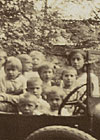A Dozen Scenes from Soviet Education, 1921
Introduction
 Three Dutch schoolteachers took a research trip to Soviet Russia in May 1921.
Three Dutch schoolteachers took a research trip to Soviet Russia in May 1921.
As communists they were mainly interested in the experimental United Labour Schools (Edinaya Trudovaya Shkola). A United Labour School was much like a conglomeration of workshops and was usually housed in a former monastery or farmhouse. Students were taught several forms of labour in the printing section, the photography studio, the spinning section, the sawmill, laboratory, and other areas; they studied these as a continuing process from toddler to adolescent. Thus, in the process they acquired an "encyclopedia of culture." This included working together with farmers in the fields or workers in factories.
The Dutch visitors travelled in and around Moscow. They did not notice the social unrest and famine of that time. They also visited a nursery, schools for young biologists and for artists, a children's sanatorium and a kindergarten.
Here, as in the United Labour Schools, many activities such as building with wooden blocks or dressing one's self were defined as "labour".
Back in Holland, one of the travelers, Jan Ceton (1875-1943) a schoolteacher from Amsterdam, wrote a pamphlet about his experiences in the "land where civilization truly reigns". As a result of this, however, Ceton was no longer trusted as a teacher in Holland. He was fired in September 1921. Practical impediments and ideological problems prevented the United Labour Schools in Soviet Russia from being realized.
Further reading:
Biographies of the travelling schoolteachers:
Jan Cornelis Ceton
Jan Cornelis Stam
Brecht Takes (van den Muijzenberg-Willemse)
J.C. Ceton, School en Kind in Sowjet-Rusland
Amsterdam 1921
Call number: Bro N 34/6
